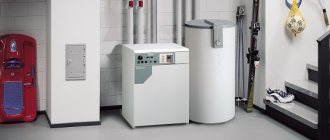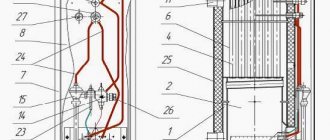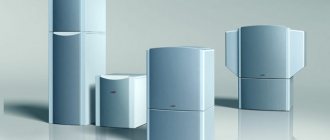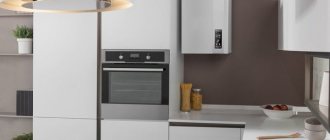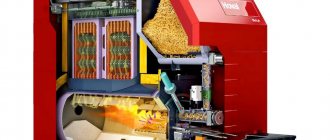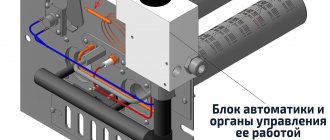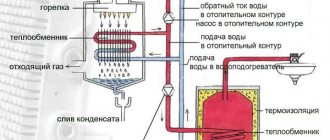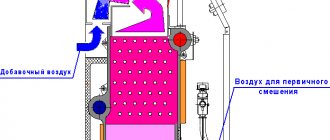Calculating the consumption of pellets for heating in advance is the first task of the owner of a private house who wants to install a pellet boiler. After all, granular fuel is more expensive than firewood, and the price of equipment is higher compared to solid fuel or electric units. One burner for burning pellets is comparable in cost to an entire wood-burning heat generator. To find out the costs of pellet heating, you need to make a simple theoretical calculation, which will be discussed further.
Pellets
The compressed pellets, 6–8mm in diameter and up to 50mm in length, are made primarily from waste wood and are considered an environmentally friendly, renewable and carbon-neutral fuel. The granules are made without any kind of chemical additives. When burned, pellets emit more heat than wood, gas or diesel fuel. And at the same time, the price for them does not rise as catastrophically as for other types of fuel.
Pellets differ in their raw materials and the method of processing, which determine the color of the finished product. White pellets are obtained from wood waste. Gray - from a mixture of wood with bark and peat or seed husks. Black pellets are produced from the same raw materials, but by oxygen-free firing at high temperatures; their calorific characteristics are similar to coal, do not rot and are water-repellent.
Many boiler owners speak negatively about the quality of domestic pellets. Although it is difficult to rely only on reviews. Each region has its own producers of this type of solid fuel, and you can only find out what quality the pellets were after burning them. Even clean seed husks burn well and provide enough heat with the correct granule manufacturing technology. It is recommended to determine the approximate quality of granules by their appearance. They should be shiny, without cracks, at least 10 mm long, and not crumble into dust in your hands.
What are pellets
Pellets are fuel granules, and more specifically, they are environmental fuel produced from waste from agriculture and the sawmill industry. Fuel pellets are distinguished not only by their harmless composition, but also by other equally important properties.
For example, the moisture content of pellets is only 8-10%, while for ordinary firewood this figure can reach 50%. The density of pellets is also much higher than wood. But the most important difference between pellets and firewood is their calorific value. It is much larger for fuel pellets.
For example, 1 ton of pellets is capable of releasing about 3.5 thousand kW of heat, which is almost 1.5 times more than when burning wood, and up to 2 times less than the heat produced by coal. Just in terms of their calorific value, pellets give good results, in many ways similar to coal. Actually, this is where the no less common name for fuel pellets, such as “biochar,” came from.
Pellet boilers
Solid fuel boilers, which use pellets as fuel, are used for heating private houses and small public buildings and heating water.
Modern automation allows you to maintain a comfortable temperature in the room, which can be set depending on the time of day and season. Wood pellets are fed from the hopper to the firebox as needed using a special auger, which is controlled automatically. When the set temperature is reached, the auger stops and the granules are not fed into the firebox. Typically, the volume of the bunker allows you to store a supply of pellets for several days. If you can organize a warehouse for storing pellets, from which they are immediately supplied to the bunker, then the process becomes more convenient . Experts recommend using a pellet boiler in combination with a backup device using another heat source, most often electricity. But today there are models on the market that can, if necessary, work with both wood and briquettes.
According to consumer reviews, which have something to compare with, in terms of requirements for location, installation and safe operation, pellet boilers are no different from gas or liquid fuel devices. Modern models are quite compact, differ from analogues in the small volume of the combustion chamber and a special burner with high efficiency. They are also characterized by a service life of up to twenty years (at least according to the instructions) and a high level of automation.
Manufacturers claim that if there is a special warehouse with a pellet supply system, the device can operate without human intervention throughout the entire heating season. According to reviews, an autonomous feeding system requires careful installation and precise adherence to geometry, otherwise granules will get stuck at the bends of the pipes, disrupting the smooth operation of the system.
Pellet boilers are available in various capacities, from 15 to 100 kW . Manufacturers recommend determining the required boiler power at the rate of 1 kW per ten square meters of area plus fifteen percent for the heat loss of the house. Reviews from owners of country houses confirm these data. Since houses are built and insulated for domestic winters, even without a margin of fifteen percent, the temperature in the rooms is maintained at a comfortable level.
Calculation of pellet consumption - initial data
To find out the theoretical fuel consumption for heating a country house, you need to collect the following initial data:
- the amount of heat load on the heating system of a cottage or country house, expressed in kW;
- Efficiency of the pellet boiler model that you plan to install in your furnace;
- calculated heat of combustion of fuel pellets;
- To get the result in monetary terms, it is advisable to find out the price per ton of pellets in your region of residence.
The most difficult thing is to get a figure for the actual heat load. It consists of heat losses through external walls, roofing, glazing and floors, plus the cost of thermal energy for heating the ventilation air.
The ideal option is to contact a qualified heating engineer for such a calculation, then you will find out the exact figure. Otherwise, you will have to calculate the thermal load and fuel consumption in aggregated ways:
- Based on specific heat consumption per square meter of area. For dwellings in central Russia, it is assumed that in a room with 1 window and one external wall, 100 W of heat per 1 m² will be consumed, with two external walls - 120 W/m², with 2 walls and two windows - 130 W/m².
- The same applies to the volume of premises. The method is used when the ceilings of the rooms exceed 2.8 m. The total heated volume is calculated, the resulting figure is multiplied by 40 W.
Comment. In the calculation example discussed below, the heat load for a private house of 100 m² is conventionally assumed to be 10 kW, since pellet consumption is determined in an abstract building with a pellet boiler from an unknown manufacturer.
The heating unit together with the bunker takes up a lot of space; one of the placement options is in the basement or ground floor. The efficiency
of the heat generator burning wood pellets is indicated in its technical data sheet. If the model and manufacturer have not yet been selected, then for calculations you can take the figure of 80%. Manufacturers leading the rating of heating equipment (for example, Viessmann or Buderus) declare the efficiency of their pellet boilers to be 85%. But these are high-quality and reliable units that are not cheap. More affordable heaters are not as efficient.
The theoretical calorific value of pellets is a known value; it lies in the range of 4.9–5.2 kW/kg, depending on the quality of the fuel and the raw materials from which they are made. If you do not take into account peat granules with high ash content and low heat transfer, then for calculations it is worth taking the average figure - 5 kW / kg.
Advantages of pellet boilers
Pellet boilers have undoubted advantages:
- Pellets are by far the safest fuel when compared to gas and electricity. But no one mentions such a positive aspect, and, most likely, because no one had any problems in this regard.
- Significantly reduce heating costs compared to electric ones. They have been actively used in Russian realities for several years now, and the reviews of their owners can be trusted. These are not theoretical calculations from foreign sources, but a statement of fact. Some say the costs are reduced by half, others by thirty percent (if you use a two-tariff meter) compared to electric heating devices. With regard to gas, the situation is the opposite. But gas is not available everywhere, and even gas cylinders are not always available. And gas is an explosive substance, unlike pellets.
- High efficiency up to 95% . Manufacturers talk about 97% in some models.
- Availability of an additional hot water supply circuit.
- Pellets are convenient to transport and store, they do not cause allergic reactions, are environmentally friendly and non-toxic. The only requirement for the room for storing them is dryness.
- Pellets are becoming more affordable every year. Today there are already many enterprises producing wood pellets. If several years ago consumer reviews spoke of a shortage of such fuel and the need to stock up on it from the summer for the entire heating season, now the excitement has subsided, and no one sees the need to store ten tons of fuel at once.
- The price of pellets is more stable than electricity or gas tariffs, and now that more and more of them are being produced, its seasonal fluctuations are not so noticeable.
- Heating a country house using a pellet boiler does not require approval for connection and operation; if desired, the equipment can be installed independently.
- Ash after combustion of pellets consists of natural minerals, and there are no problems with its disposal, as their owners have repeatedly noted on forums.
conclusions
If you analyze the reviews and collect more statistics, it turns out that the estimated consumption of pellets for heating is not too different from the real one. If initially the calculation was made according to an enlarged scheme, the results are comparable to fuel consumption in a poorly insulated private house. When you have real indicators of the heat load, then you can calculate the financial costs of pellet heating quite accurately.
When calculating costs, do not forget about the electricity consumption of the boiler, for which you also pay money on the meter. It must be taken into account, because the power consumption of the auger motor, electric ignition device and controller can reach 400-500 W/h, which is quite significant. It can be supplemented by the power of an additional screw conveyor, if you have one installed to move pellets from the storage to the bunker.
Disadvantages of pellet boilers
It would seem that pellet stoves have so many advantages that they should already be in every country house, but the disadvantages get in the way:
- Quite a high price. It has been declining in recent years, but still exceeds the cost of gas and electric analogues. The cost of a pellet boiler is twice as high as a gas boiler of the same power. But there are separate burners that can be installed in an existing solid fuel boiler.
- Need for constant care . Throughout the heating period, almost every week you need to clean the heat exchanger with a special brush and remove ash from the ash collector. True, this applies to outdated models. Modern devices have an automatic cleaning function. And the frequency of such work directly depends on the quality of the pellets. This drawback is noted by all owners of pellet stoves.
- If there is no warehouse with automatic supply of pellets, the bunker must be loaded manually at least once a week, depending on its size. But this is a common drawback of all solid fuel devices.
- The need for a sufficiently large dry room for storing pellets. Even for the smallest 10 kW boiler, according to reviews, 2 kg/hour or 2 bags of 25 kg of pellets per day are required, that is, about one and a half tons of pellets are needed for a month, and they need to be stored in a dry room or a large container. True, the environmental safety and absence of odors in pellets allows this volume to be used for other purposes in the warm season.
- In remote areas, there may be complications with the purchase of high-quality pellets, their delivery and servicing of imported equipment, which, to be honest, was not designed for the harsh Russian winters and the quality of the fuel.
Heating with pellets: profitable or not, myths and reviews
Let's consider the most common questions regarding the benefits of heating with pellets, their pros and cons:
- Pellets burn better than firewood, is it really possible that something is added to them and this makes them less environmentally friendly? In fact, this is a fairly common and also erroneous opinion. As mentioned above, only harmless raw materials are used for the production of fuel pellets. For example, substances that do not pose a threat to human health are also used as binders for wood waste.
Answering specifically the question of why pellets burn better than firewood, first of all you need to say this:
- The density of fuel granules (pellets) is an order of magnitude higher than that of wood;
- The humidity of pellets is lower.
In addition, the structure of the pellets itself contributes to their better combustion. Do not forget that pellets are burned in boilers specially designed for this purpose, with forced air supply.
How many pellets do you need to heat a house?
- You need much less pellets than firewood to heat the same room. Indeed, heating with pellets shows good results in terms of calorific value. For example, just one kilogram of pellets can produce about 5 kW of heat per hour. Considering that to comfortably heat 10 sq/m you need only 1 kW of heat, then with five kilowatts you can heat a small house of 50 square meters.
- Will pellets burn in a regular stove or boiler? Without a heating boiler with forced air supply into the combustion chamber, it is quite difficult to use fuel pellets for heating. They will burn, but then we can’t talk about any savings, and the combustion of pellets, in this case, will largely depend on how good the draft in the chimney is.
- Pellets can be stored as much as you like, anywhere, and in any conditions. No, this opinion is wrong, and there are a number of strict requirements for storing pellets. Firstly, pellets are afraid of moisture, which, when it comes into contact with them, is successfully absorbed by the granules, after which they also crumble into pieces and become unsuitable for use. Therefore, pellets should only be stored in dry rooms, avoiding sudden temperature changes in them, in order to avoid the formation of condensation.
- 5. Which pellets are better, white or gray? This question is also a common misconception among those who decide to switch to pellet heating.
The color of fuel pellets has nothing to do with their quality, which can only be determined after burning a certain amount of this fuel. And, nevertheless, there are clear visual signs of identifying high-quality and low-quality pellets. So, for example, high-quality pellets should be free of cracks, have a length of at least 7 mm, shine in the light and not crumble if you try to lightly rub them in the palm of your hand.
Rate this article and share the link:
Leading manufacturers
There are now devices from Russian and foreign manufacturers on the market.
Russian-made boilers
Despite the fact that most owners agree that they have more disadvantages than advantages, Russian pellet makers are produced by several serious enterprises:
- It is worth highlighting “Oranges” produced by NCC Biyskenergoproekt, which got their name for their bright color. They are characterized by an optimal price-quality ratio and an efficiency of 93% with ease and reliability of use. "Orange" is equipped with electronic control, automated fuel loading and forced ventilation. Focused on the domestic pallet market with their quality. At the same time, the cost of “Oranges” is on average 150 thousand rubles.
- Start boilers are manufactured in Chelyabinsk, however, they are equipped with Polish volumetric combustion burners, which allow complete combustion of fuel and high efficiency. “Start” is a combination boiler and, in addition to pellets, can operate on coal, wood, and small chips. For this purpose, the kit includes a cast iron grate, which is installed instead of the burner. Price ranges from 130-250 thousand rubles.
- The Krasnoyarsk Zota Pellet consumes various types of fuel; its functions include the ability to control the heating process using SMS messages. The line includes five models with a power from 15 to 100 kW, which are used in closed heating systems (with forced circulation). According to reviews, they functionally correspond to the Finnish Auterm Biomatic, but are half the price, and the Grandeg models of the same price category are one step lower in function.
- Pellet boilers "Kupper" LLC "Teplodar" from Novosibirsk, whose power ranges from 10 to 40 kW, are converted conventional solid fuel boilers with a pellet burner. Owners note its low price of about 80 thousand rubles depending on the model, the difficulty of setting up, the need to select high-quality pellets and minor modifications such as grinding the auger bolt (it protrudes very much, because of this the pellets get stuck in the hopper).
Our village is small, they promised to supply gas in three years. I wanted to install solid fuel heating, but there was nowhere to store firewood and no time to do it. Service technicians will not come to us, so I chose a boiler from a serious specialized plant. I chose “Kupper” , which is one and a half times cheaper than other manufacturers of the same power. With the difference in price, I will be able to heat a 100 square meter house for just two years.
Fedor Mikhailovich
How to calculate pellet consumption
The calculation is carried out in several stages, although in general it is quite simple. Its result should be the average monthly fuel consumption of a pellet boiler during the heating season and the average cost of such heating. For clarity, we will look at an example calculation for a 100 m² house.
The torch-type burner automatically ignites and goes out at the command of the controller, this allows for significant fuel savings
Stage one. First you need to understand how much heat actually enters the heating system when burning 1 kg of fuel pellets. After all, heating equipment is not so perfect as to direct all the energy received to heat the house; part of it will fly out into the chimney. To do this, the combustion heat of the granules should be multiplied by the efficiency of the heat generator, divided by 100:
5 kW/kg x 80% / 100 = 4 kW/kg.
Stage two. For ease of calculation, you need to do the opposite to find out how many pellets you need to burn to obtain 1 kW of thermal energy in real conditions:
1 kW / 4 kW/kg = 0.25 kg.
Stage three. During the heating season, the weather outside changes and the temperature ranges from +10 °C to -30 °C. The average specific heat consumption for the entire season for a house of 100 m² will not be 10 kW, but half as much - 5 kW. Considering that power units are assigned to a time of 1 hour, the heat consumption per day will be:
5 kW/h x 24 hours = 120 kW.
The same, only for a month:
120 kW x 30 days = 3600 kW.
Stage four. Now it is easy to calculate the average consumption of pellets per month for a building of 100 m² during the entire heating season:
3600 kW x 0.25 kg/kW = 900 kg.
If the cold season lasts 7 months, as in Moscow, Russian Federation, then the total amount of fuel pellets for heating a private house with an area of 100 square meters will be 900 x 7 = 6.3 tons. The average monthly consumption of pellets for a house with an area of 150 and 200 m² is determined in the same way; it is equal to 1.35 and 1.8 tons, respectively. Since pellets are sold by weight and not by volume, there is no need to convert this quantity into volumetric units.
Those who are interested in the approximate consumption of wood pellets on average per day can calculate it in this way (for our example):
120 kW x 0.25 kg/kW = 30 kg.
Attention! The average calculated value should not be confused with actual fuel consumption on the coldest and warmest days. In a building of 100 m² it can vary between 15-60 kg of pellets per day.
To get approximate costs for pellet heating in monetary terms, you need to multiply the obtained figures by the price per ton accepted in your region. At prices in the capitals of the Russian Federation and Ukraine, monthly heating costs for a private house of 100 square meters will be:
- for Moscow: 0.9 t x 8500 rub/t = 7650 rub;
- for Kyiv: 0.9 t x 3000 UAH/t = 2700 UAH.
A retort burner is cheaper than a torch burner; it can be installed in a regular TT boiler.
It must be taken into account that we carried out an abstract calculation; in the conditions of Ukraine, financial costs for pellet heating will be lower due to the milder climate.
